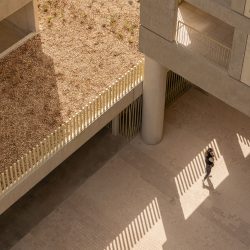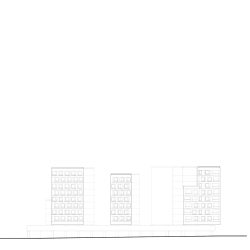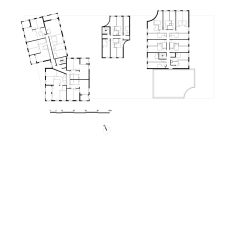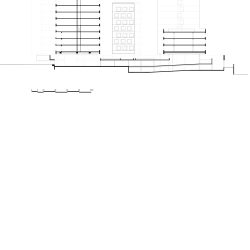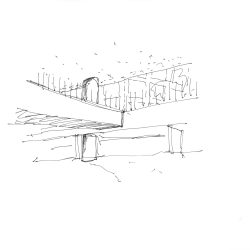
Atelier Stéphane Fernandez . photos: © Stéphane Aboudaram | We Are Contents
This residential complex of 188 units of student housing and 50 flats for families emerges from the Empalot site, in the city of Toulouse, at the point connecting the housing estate dating from the 1960s, the new footbridge that straddles the Garonne to the Île Ramier, and the sports field that serves as the district’s central point. The project is designed to give inhabitants a tangible “at home” feeling and to create a mellow urbanity that can reconcile the surrounding architecture’s disparate silhouettes.
Though courteous, the Formes Hautes are no less assured for, even if the approach is reparative, it is above all forward-looking. The architecture is strong, determined, protective, open, porous, appropriable, and transformable. It has been designed for the long term: the generous structural grid makes possible the reversibility of the car parks into a public or cultural facility (district library, cultural center), the evolution of housing, and student cells can all be easily transformed into family flats. Prefabricated façade modules are inserted into these grids, which in forty or fifty years, could easily be replaced to meet new environmental or socio-cultural challenges.
From an urban point of view, the city superblock respects the natural ground cover. It settles upon it without invading, inspired by the Japanese manner of landscaping, yet rises to the challenge of replicating it in height, thanks to a podium that closely adheres to the perimeter of the lot, thereby emphasizing the unity of the complex. Within this limit are shared spaces, streets, squares, patios, ramps as well as two levels currently used as a car park.
This inhabitable substructure punctuated by strong columns, playing with dilatation as much as compression, creates a hypostyle space crossed by long perspectives that direct the gaze towards interior spaces, city, and landscape.
From this solid and porous matrix, three blocks of flats loom up (G+7, G+6, G+3), with a view across the river towards the older city and the Île du Ramier. The architecture leaves the ground at the same time it is tethered to it, in a permanent search for strength and elegance that finds its full expression in the work with materials (onsite concrete, limestone paving stones), in the colours, and the precision of the design.
The composition of the Formes Hautes is skillful and the movement continuous: the blocks are unaligned, slipping, and entering into tension with each other; the volumes are sculpted by bevels and flutes that catch the light, enabling the surfaces and angles to exist; the geometry of the windows plays with kinetics and increases the number of optical effects.
The architecture participates in building the city based on an innovative partition that works with the superblock at every scale and in all its dimensions. Here, the present aims to simultaneously contain the past and the future (of the city).
_






